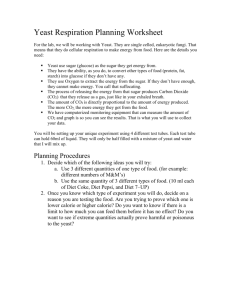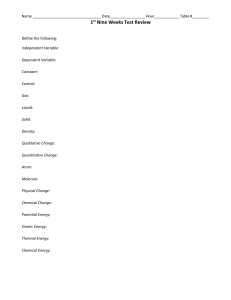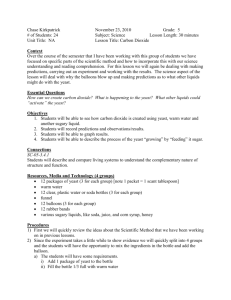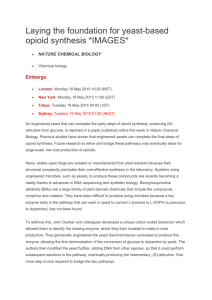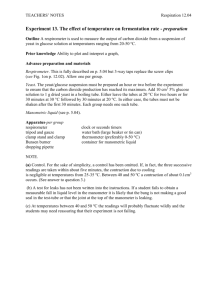Cell Biology: Is Yeast Alive?
advertisement
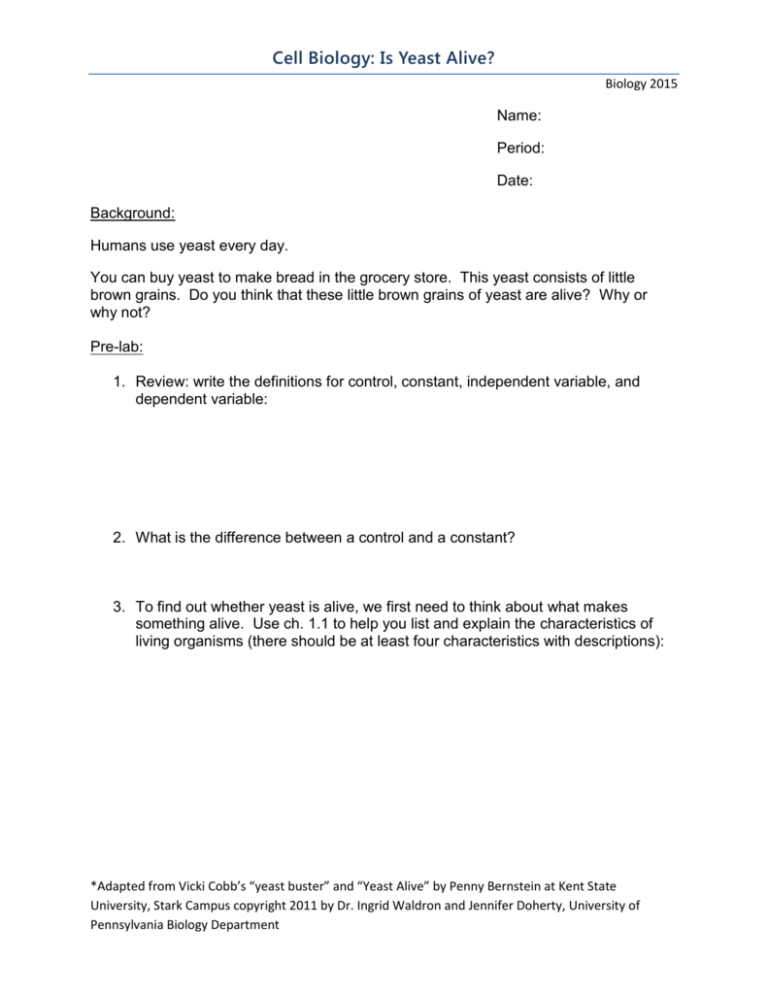
Cell Biology: Is Yeast Alive? Biology 2015 Name: Period: Date: Background: Humans use yeast every day. You can buy yeast to make bread in the grocery store. This yeast consists of little brown grains. Do you think that these little brown grains of yeast are alive? Why or why not? Pre-lab: 1. Review: write the definitions for control, constant, independent variable, and dependent variable: 2. What is the difference between a control and a constant? 3. To find out whether yeast is alive, we first need to think about what makes something alive. Use ch. 1.1 to help you list and explain the characteristics of living organisms (there should be at least four characteristics with descriptions): *Adapted from Vicki Cobb’s “yeast buster” and “Yeast Alive” by Penny Bernstein at Kent State University, Stark Campus copyright 2011 by Dr. Ingrid Waldron and Jennifer Doherty, University of Pennsylvania Biology Department Cell Biology: Is Yeast Alive? Biology 2015 To begin to answer the question, "Is yeast alive?”, you will test whether the grains of yeast have two characteristics of living things -- the ability to grow and the ability to use energy (referred to as metabolism). Scientific Experiment to Test for Metabolism We will carry out an indirect test for metabolism. In other words, we will be indirectly testing whether yeast can use energy, which is one of the characteristics of living organisms. When yeast, humans, and other living organisms use energy, they break down highenergy molecules like sugar to get the energy they need and give off a gas called carbon dioxide as a by-product of this reaction. We will test whether yeast can metabolize sugar and produce a gas which we will presume is carbon dioxide. Specifically, we will test whether yeast produces a gas when it has sugar available as a food vs. when no sugar is available. Research Question: Does yeast metabolize sugar and produce a gas? Predictions: Do you expect yeast to produce a gas when sugar is available? ______ Do you expect yeast to produce a gas when no sugar or other food is available? _____ Write the hypothesis for the experiment here: ______________ addition will enable ___________ to produce ____________ ______________ _______. Variables: List and explain the control for this experiment, the independent variable, and the dependent variable (s): 1. The independent variable will be _____________because_________ 2. The control will be_______________because___________________: 3. Dependent variable will be: *Adapted from Vicki Cobb’s “yeast buster” and “Yeast Alive” by Penny Bernstein at Kent State University, Stark Campus copyright 2011 by Dr. Ingrid Waldron and Jennifer Doherty, University of Pennsylvania Biology Department Cell Biology: Is Yeast Alive? Biology 2015 Required Materials 2 half-liter bottles of bottled water ,funnel ,measuring spoons ,sugar , labels , pen or pencil ,shampoo , bakers yeast , 2 identical helium-quality rubber balloons , string and ruler Procedure: 1. Fill each bottle halfway with water; leave an equal amount of water in each bottle. (Save the bottle caps.) 2. Add 1 tablespoon (3 teaspoons) of sugar to one bottle ONLY. Put the cap on the bottle and shake until sugar dissolves. 3. Label the bottle without sugar the CONTROL. 4. Remove the caps and add 1 teaspoon of dried bakers yeast to each bottle. Put the caps back on the bottles and invert them slowly back and forth to thoroughly mix the contents without causing foam to form from the shampoo 5. Put 1/2 teaspoon of shampoo into the sugar-water bottle and the bottle without sugar/CONTROL. 6. Remove the bottle caps and quickly stretch the mouth of a balloon over the top of each bottle. Make sure that the neck of each balloon completely covers the screw channels at the top of the bottle. 7. Note the time and write it down: 8. Observe the test tubes and record your observations carefully in the table on the next page. Then, every 5 minutes for 25 minutes, observe what occurs in the test tubes and any changes in the balloons which cover each bottle, and record your observations. If the yeast grains are capable of metabolism, it will take some time to produce enough carbon dioxide to see the change in the balloons. 9. You will need to wrap a piece of string around the balloon once it starts to fill. Hold string position and then remove from balloon. Use ruler to record measurements every 5 minutes. 10. While you are waiting for balloon observations, construct a graph for your results on the grid provided. *Adapted from Vicki Cobb’s “yeast buster” and “Yeast Alive” by Penny Bernstein at Kent State University, Stark Campus copyright 2011 by Dr. Ingrid Waldron and Jennifer Doherty, University of Pennsylvania Biology Department Cell Biology: Is Yeast Alive? Biology 2015 Name and Period Observations (written description) of Yeast Bottles and balloon measurements (don’t forget units!) 0 minutes Bottle 1 (with Sugar and shampoo) 5 minutes 10 minutes 15 minutes 20 minutes 25 minutes Example: Balloon deflated and only 8 cm in diameter Bottle 2 (water and shampoo) *Adapted from Vicki Cobb’s “yeast buster” and “Yeast Alive” by Penny Bernstein at Kent State University, Stark Campus copyright 2011 by Dr. Ingrid Waldron and Jennifer Doherty, University of Pennsylvania Biology Department Cell Biology: Is Yeast Alive? Biology 2015 1. Discuss the results you obtained with your group. How do you interpret your results? Describe whether the relationship between variables was positive, negative, or neutral. Do your results match your predictions? 2. Why did you need one bottle without sugar? 3. When you make bread, if you just mix flour, sugar and water, the dough does not rise, and the bread will be flat and hard. If you include yeast in the bread dough, then the dough rises and the bread is bigger and fluffier. Can you explain how the yeast helps the bread dough to rise? 4. What did you observe about the bottle and balloon at the end of the experiment (use your senses: sight, smell, sound etc.)? How do you explain the changes? 5. What role does shampoo play in the process of yeast metabolism in your experiment? *Adapted from Vicki Cobb’s “yeast buster” and “Yeast Alive” by Penny Bernstein at Kent State University, Stark Campus copyright 2011 by Dr. Ingrid Waldron and Jennifer Doherty, University of Pennsylvania Biology Department


